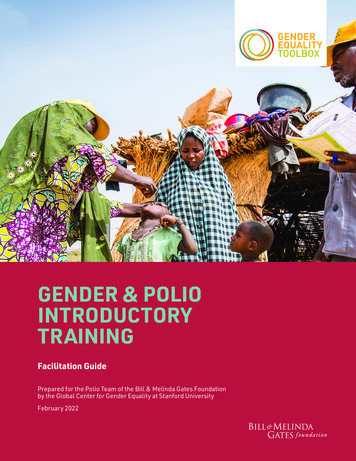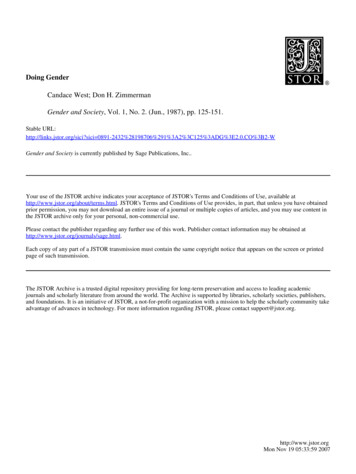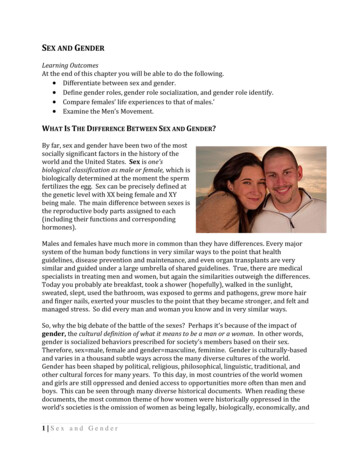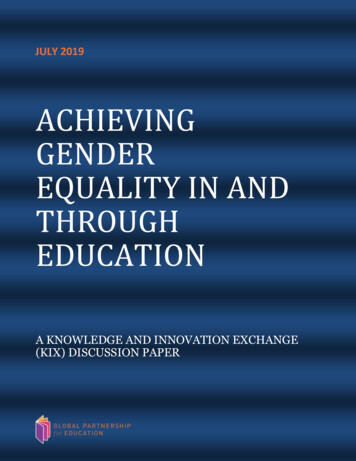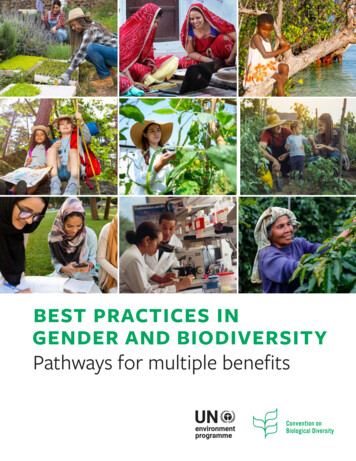
Transcription
BEST PRACTICES INGENDER AND BIODIVERSITYPathways for multiple benefits
Published by the Secretariat of the Convention on Biological Diversity.Copyright 2022, Secretariat of the Convention on Biological DiversityThe designations employed and the presentation of material in this publication do not imply the expression of any opinion whatsoever onthe part of the Secretariat of the Convention on Biological Diversity concerning the legal status of any country, territory, city or area or of itsauthorities, or concerning the delimitation of its frontiers or boundaries.The views reported in this publication do not necessarily represent those of the Convention on Biological Diversity.This publication may be reproduced for educational or non-profit purposes without special permission from the copyright holders, providedacknowledgement of the source is made. The Secretariat of the Convention would appreciate receiving a copy of any publications that usethis document as a source.CitationSecretariat of the Convention on Biological Diversity (2022). Best practices in Gender and Biodiversity: Pathways for multiple benefitsFor further information, please contact:Secretariat of the Convention on Biological Diversity413 St. Jacques Street, Suite 800Montreal, Quebec, Canada H2Y 1N9Phone: 1 514 288 2220Fax: 1 514 288 6588E-mail: secretariat@cbd.intWebsite: www.cbd.intLayout and design: Em Dash Design www.emdashdesign.caCover photosTop row, left to right: AlessandroBiascioli/shutterstock.com; Mukesh Kumar Jwala/shutterstock.com; Damian Ryszawy/shutterstock.comMiddle row, left to right: Sergey Novikov/shutterstock.com; bunyarit klinsukhon/shutterstock.com; Likoper/shutterstock.comBottom row, left to right: Dean Drobot/shutterstock.com; National Cancer Institute/unsplash.com; BK Awangga/shutterstock.com
BEST PRACTICES INGENDER AND BIODIVERSITYPathways for multiple benefits
AcknowledgementsThis publication was prepared by Soma Chakrabarti-Fezzardi for the Secretariat of the Conventionon Biological Diversity, under the direction of Tanya McGregor, Gender Programme Officer of theSecretariat. The Secretariat thanks the Government of Sweden for its generous financial assistanceenabling the production of this publication. The Secretariat also wishes to thank the many contributorsto this report, who submitted case studies in response to it’s call for inputs on best practices.1 In total,over 70 case study examples were received in 30 separate submissions to the Secretariat. In order todemonstrate the range of initiatives underway and include inputs from the many submissions received,this publication contains 27 short best practice ‘snapshots’ in addition to ten detailed case studies.Unfortunately, not all of the submissions received could be included in this document, however theseinputs will inform further research and may be highlighted, where appropriate, in future communicationsefforts.The Secretariat acknowledges the receipt of submissions from the followingorganizations and country Parties:Acción por la Bioversidad; Government of Australia, Department of Agriculture, Water and the Environment;CBD Women’s Caucus members (Kalpavriksh; Amhi Amchya Arogyasaathi; Deccan Development Society;WWF Indonesia; Yayasan Wasur Lestari); FoMMA (Alliance of the People of the Kayan Mentarang NationalPark); GOW (The United Association of Women’s Organizations); Edna Kaptoyo; Cicilia Githaiga; Janet J.Kiptanui; Reseau des Femmes Africaines pour la gestion Communautaire des Forets (REFACOF); Mujeresy Ambiente SPR de RL de CV; CoopeSoliDar R.L; Marine Ecosystem Protected Area Trust); Gaia Amazonas;Global Forest Coalition members (BIOM Ecological Movement, Peasant and Community Reserves Collectiveof Santander, Colombia, The Development Institute, Indigenous Information Network); German FederalMinistry for the Environment, Nature Conservation and Nuclear Safety; Government of Burkina Faso;Government of Canada, Ministry of Environment and Climate Change Canada; Government of China,Department of International Cooperation, Ministry of Ecology and Environment; Government of Ecuador,Directorate of Environmental and Sustainable Development Ministry of Foreign Affairs and Human Mobility;Government of France; Government of Equatorial Guinea, Ministry of Agriculture; Government of Mexico,Comisión Nacional para el Conocimiento y Uso de la Biodiversidad (CONABIO), Ministry of Global Affairs;ICLEI; IDEP Foundation; IFAD; India Water Foundation; Integrated Land and Resource Governance (ILRG)Program Zambia; International Fund for Animal Welfare (IFAW); International Union for Conservation ofNature (IUCN); Keystone Foundation; Mujeres y Ambiente SPR de RL de CV; Rainforest Foundation Norway;SwedBio at Stockholm Resilience Centre and partners (International Development Law Organization(IDLO)); United Nations Development Programme (UNDP); ICLEI – Local Governments for Sustainability;Wildlife Conservation Society Myanmar; Alianza Biodiversidad; Gender in Aquaculture and Fisheries Sectionof the Asian Fisheries Society (GAFS); African Biodiversity Network (ABN); Sustainable DevelopmentFund (SDF); Somali Greenpeace Association; United Nations Environment Programme (UNEP); WildlifeConservation Society (WCS) Bolivia1CBD Notification 2020-040 - Transformational Change: Best Practices for Gender-responsive Biodiversity Policy and Action - Call for contributions
CONTENTSForeword . . . . . . . . . . 3Acronyms. . . . . . . . . . 4Key Messages . . . . . . . . 6Introduction. . . . . . . 9Key Findings . . . . . . 11Action areas. . . . . . 11Implementation mechanisms. . . . . . . 14Best practices – meeting the criteria. . . . . . . 18Conclusions . . . . . . 25Case StudiesArmenia: Fostering forest resilience and women’s equal energy access. . . . . . . . 27Belize, Barbados and Fiji: Networking, building capacity and awareness. . . . . . 32Bolivia: Concursos and cadernetas ecologicas transform landscapes and gender relations. . . . . . . 37Costa Rica: Data analysis, policy and institutional innovation to close gender gaps. . . . . . 41Ghana: A gender mainstreaming theory of change for fisheries governance . . . . . . . 44Mexico: Gender responsive NBSAPs and programming. . . . . . 49Nepal: Women’s participation in biodiversity governance. . . . . . 54Sudan: Gender responsive natural resource management for peace. . . . . 60Tunisia: Boosting shell clam populations and women’s empowerment. . . . . 64Uganda: Integrating gender actions under Rio Conventions. . . . . . 68Best Practice SnapshotsCountry examplesAustralia: Advocating for women’s access to benefits and voice in water governance. . . . . . 73Bangladesh: Land tenure security. . . . . . . 74Brazil: Women and men agrobiodiversity guardians. . . . . . 74Colombia: Buen Vivir (living well) and biodiversity to empower women. . . . . . 75Ecuador: Gender capacity development for effective ABS implementation. . . . . . 76China: Gender mainstreaming standards making a difference. . . . . . 77Costa Rica: Supporting formalization of women’s informal collectives for decent work. . . . . . . . 77Eswatini: Changing customary practices for inclusive natural resource management. . . . . . . . 78Ethiopia: Women making a difference on the front lines of dangerous zoonotic disease spread. . . . . . 78Germany: Identifying men’s and women’s different perceptions of nature. . . . . . . . 79 1
India: Global campaign of women on biodiversity, cultural diversity and food security . . . . . . . 80India: Women ‘barefoot ecologists’ support environmental monitoring. . . . . . 81Indonesia: Gender responsive environmental law enforcement. . . . . . . . 82Indonesia: Including women in Payment for Ecosystem Services (PES) benefits and decision making. 82Kenya: Community women break gender stereotypes to become wildlife rangers . . . . . . . . 83Kenya: Including women’s priorities in Biocultural Community Protocol. . . . . . 84Kyrgyzstan: Alternative avenues to empower women through biodiversity protection. . . . . 85Lao PDR: Putting women at the heart of NBSAPs. . . . . 85Malawi: Data driven forest management for equity. . . . . . 86Mozambique: Engaging men and boys in addressing gender inequality in the household. . . . . . . 86Myanmar: Women’s leadership and economic empowerment in fisheries. . . . . 87Philippines: Women champions mobilize crowdfunding to save endangered buffalo species. . . . . . 87South Africa: Women are central to implementation of national community seedbank strategy. . . . . 88Tanzania: Women leaders shape urban nature. . . . . 88Uganda: Women with no assets access carbon purchase agreements as loan collateral. . . . . . 89Zambia: Women gain entry into wildlife governance and employment. . . . . 90Regional/multi-country examplesAfrica: Women participating in city planning and decision-making processes. . . . . . 91Asia: Mainstreaming gender equity in large scale mangroves programme. . . . . . 92Annex 1. Capacity development tools and toolkits to strengthen gender responsive biodiversitypolicy and action. . . . . 93Annex 2. Research and knowledge products on gender and biodiversity. . . . . 95
FOREWORDThe international community is increasingly recognizing the range of waysin which gender differences and inequalities shape how we take decisionsand our impact on the natural world. Deeply entrenched social normsadvantage more powerful and dominant groups over others, and mostoften men and boys over women and girls. Tackling these long-standinginequalities and structural barriers is a complex process that requiresdedicated attention and resourcing. This collection of best practicesshows us how such targeted action is also critical to achieve sustainableand transformative results for biodiversity.The detailed case studies provide an in-depth look at steps taken at different stages of project developmentand implementation that contribute to achieving outcomes for gender equality and biodiversity. Theyillustrate the importance of gender analysis, including baseline studies and targeted household surveys,in determining the context and specific gender differences and gaps to be addressed. The case studiesand ‘snapshot’ best practices are also inspiring in demonstrating the potential for action to be taken atmany different scales and through different types of partnerships – from establishing a public-privateproducer partnership to develop a fair-trade certification, to initiating national fora for women working inthe fisheries’ sector to come together to share experience and build capacity, to developing and trackingthe implementation of a gender-responsive national biodiversity strategy and action plan, and more. Theexamples showcase innovative approaches, such as how engaging women in natural resource mapping andensuring their equal participation in determining financing priorities can lead to improved food security andnutrition as well as increased leadership roles for women.These examples demonstrate how a structured approach to identifying and addressing gender issues canadd up to a multitude of benefits. This publication highlights diverse outcomes such as improvementsin forest management and access to water, increased capacity to carry out climate change vulnerabilityassessments and adaptation planning, reduction in illegally caught fish, increased leadership roles forwomen in peace processes and environmental governance, as well as improved perceptions of women’scapacities, and improvements in their status, earnings and social benefits.I invite you to take some time to look through these pages and learn about different initiatives that are helpingto set a new course for biodiversity conservation and sustainable use that can truly benefit all, women andgirls as well as boys and men. As we move through a new decade, with a focus on transformative changetowards meeting the Sustainable Development Goals and ensuring effective implementation of a new globalbiodiversity framework, let us make use of the guidance these examples provide. Building on best practice willhelp us to achieve our shared objectives for gender equality and biodiversity conservation, and to reach the2050 vision of Living in Harmony with Nature. It will take all of us to realize a future where women and menand boys and girls can equally benefit from and contribute to a world in harmony with nature.Elizabeth Maruma MremaCBD Executive SecretaryForeword3
ACRONYMS4ABSAccess and benefit sharingBCPBiocultural community protocolEbAEcosystem-based adaptationASAPAdaptation for Smallholder Agriculture Programme (IFAD)CBDConvention on Biological DiversityBIOFINUNDP’s Biodiversity Finance InitiativeCEAPCommunity Environmental Action Planning (Sudan case study)CAFICentral African Forest InitiativeCEPFCritical Ecosystem Partnership FundCFUGCommunity Forestry User Group (Nepal case study)CONANPNational Commission for Protected Areas (Mexico case study)CONAFORNational Forestry Commission (Mexico case study)CSOCivil Society OrganizationDFIDDepartment for International Development (United Kingdom)FAOFood and Agriculture Organization of the United NationsFECOForeign Economic Cooperation Office (China snapshot)GAPGender Action PlanGBVGender-based ViolenceGCFGreen Climate FundGEFGlobal Environment FacilityGESIGender Equality and Social InclusionGFCGlobal Forest CoalitionIPLCIndigenous Peoples and Local CommunitiesLBSAPLocal Biodiversity Strategy and Action PlanBest practices in Gender and Biodiversity: Pathways for multiple benefits
ILRGIntegrated Land and Resource Governance Programme (Zambia snapshot)IUCNInternational Union for Conservation of NatureNBSAPNational Biodiversity Strategies and Action PlansNDCNationally Determined ContributionsMFFMangroves for the FutureMRVMeasuring, Reporting and Verifying (MRV)NGONon-Governmental OrganisationNRMNatural resources managementPDR(Lao) People’s Democratic RepublicPESPayment for Ecosystem ServicesSDGSustainable Development GoalREDD Reducing Emissions from Deforestation and Forest DegradationSFMPSustainable Fisheries Management Project (Ghana case study)UNCCDUnited Nations Convention to Combat DesertificationUNFCCCUnited Nations Framework Convention on Climate ChangeUNDPUnited Nations Development ProgrammeUN-REDDUnited Nations Programme on Reducing Emissions from Deforestation and ForestDegradationUSAIDUnited States Agency for International DevelopmentVGGTVoluntary Guidelines on the Responsible Governance of Tenure of Land, Fisheries andForests in the Context of National Food SecurityWCSWildlife Conservation SocietyWIFFWomen in Fisheries Forum(WIFN-Fiji)Women in Fisheries Network (Belize, Barbados and Fiji case study)Acronyms5
KEY MESSAGES1. Tackle the ‘tough stuff’Across the world, efforts are underway to tackle the underlying drivers of both biodiversity loss and genderinequality. This often involves efforts to change gender stereotypes that hamper gender and biodiversityoutcomes. For example, a growing recognition that ‘community based’ and ‘participatory’ approaches arenot necessarily ‘gender responsive’ is stimulating active efforts to truly engage all members of the communityand leave no-one behind. Working with traditional authorities is proving a successful strategy, as istaking a nuanced approach to targeting beneficiaries which recognizes gender as one of various socioeconomic factors alongside age, wealth, education, race and ethnicity and others that determine peoples’access to, decisions about and benefits from land and biological resources. Another innovative strategyis to tackle gender issues not just at community level, but also in the home. Making visible women’sunpaid household contributions with regard to natural resources management (NRM) can help to tackleentrenched gender stereotypes at their root. Efforts to address gender-based violence in the context ofbiodiversity, as well as to engage men and boys, are also key to ensure lasting change.2. Equitable access to land and natural resources remains important for multiple gainsClosing gender gaps in access to land and natural resources is a fundamental building block oftransformative change for both biodiversity and gender equality. Equitable land tenure security is soimportant that it is reflected in three Sustainable Development Goal (SDG) targets2 to achieve the2030 Agenda for Sustainable Development3, and there is specific support on integrating gender in theimplementation of the Voluntary Guidelines on the Responsible Governance of Tenure of Land, Fisheriesand Forests in the Context of National Food Security (VGGT)4 Land tenure security is about more thanformal title deeds to individually owned land – it encompasses group access rights to land as well asthe natural resources on it – such as forests, pastures, wetlands, rivers, soil, flora and fauna. Althoughimproving secure access to land and its natural resources is often perceived as being difficult to tackle,there are encouraging efforts to improve women’s access through joint land titling, equal participationin user groups and formalizing informal women’s collectives. These actions also contribute to moreequitable sharing of the benefits, including economic returns flowing from these natural resources andfrom gender responsive implementation of the Nagoya Protocol on Access to Genetic Resources and theFair and Equitable Sharing of Benefits (ABS)5 Arising from their Utilization (2010). For Parties, progress23456Target 1.4: By 2030, ensure that all men and women, in particular the poor and the vulnerable, have equal rights to economic resources, aswell as access to basic services, ownership and control over land and other forms of property, inheritance, natural resources ’. Target 2.3: ‘By2030, double the agricultural productivity and incomes of small-scale food producers, in particular women, indigenous peoples, family farmers,pastoralists and fishers, including through secure and equal access to land, other productive resources and inputs, knowledge, financialservices, markets and opportunities for value addition and non-farm employment ’. Target 5A: ‘Undertake reforms to give women equal rightsto economic resources, as well as access to ownership and control over land and other forms of property, financial services, inheritance andnatural resources, in accordance with national laws.United Nations. 2015. Transforming our world: the 2030 Agenda for Sustainable Development. Informally called Agenda 2030 or the 2030Agenda for Sustainable Development.FAO. 2013. Governing land for women and men. A technical guide to support the achievement of responsible gender-equitable governance ofland tenure.Access and benefit sharing (ABS) refers to the way in which genetic resources may be accessed, and how the benefits that result from theiruse are shared between the people or countries using the resources (users) and the people or countries that provide them (providers).Genetic resources encompass all living organisms; plants, animals and microbes, which carry genetic material that could be potentially useful tohumans. Source: CBD. 2011. Introduction to access and benefit-sharing.Best practices in Gender and Biodiversity: Pathways for multiple benefits
in equitable access to land and natural resources translates into progress towards SDG targets 1.4, 2.3, 5aand SDG 15 among others.63. Promote women’s collective action, organizations and networksMany best practices support women’s organizations and networks, creating spaces for womento build knowledge of their rights with regard to biodiversity, as well as how they can contribute toconserving biodiversity. Such organizations and networks can provide a forum for women to developtechnical skills, increase opportunities for sustainable livelihoods, and allow women to connect with eachother and with other stakeholders. The opportunity to network and build confidence in a ‘safe’ spacemay be especially important in sectors where women are particularly underrepresented in official statisticsand in leadership roles. Women’s organizations and networks may also foster and encourage women toaim for leadership roles.4. Continue to foster women’s leadershipA large number of best practices focus on supporting women’s leadership and expanding women’saccess to decision making at various levels from the home, through to the community and in policyprocesses. Strategies include engaging with women as well as men in biodiversity-related policy andprogramming processes including, but not limited to, the development, revision and implementation ofnational biodiversity strategies and action plans (NBSAPs) and project formulation, as well as reporting ongender dimensions of national progress reports. Measures to increase women’s effective participation andleadership roles in biodiversity related governance bodies are also being taken by different actors.5. Create and tap into gender responsive financing opportunitiesFunding is needed to undertake gender responsive biodiversity actions, and biodiversity financing alsoneeds to reach women and men on the ground. Climate and environmental financing mechanismswith gender related commitments appear to be stimulating greater uptake of gender considerationsin the biodiversity actions they finance; tapping into these opportunities can provide an important entrypoint for stakeholders and offer linkages to regional and global programmes with South-South learningopportunities. Parties and stakeholders should also continue to find ways to get biodiversity financing towork for women as well as men on the ground, for example through funding gender responsive nationalprogrammes, and grants specifically targeting women’s sustainable livelihoods. Innovative approachesinclude supporting crowdfunding by women environmental actors and applying women’s participationas a criterion for receiving and deciding on use of community funds. Other strategies includeallocation of funds to deliver on gender actions in national biodiversity strategies and action plans.The private sector can be an important partner, not only for direct funding, but also by providing marketsand related capacity development for gender responsive biodiversity actions.6SDG 14: ‘Conserve and sustainably use the oceans, seas and marine resources for sustainable development’ known informally as ‘life belowwater’. SDG 15: ‘Protect, restore and promote sustainable use of terrestrial ecosystems, sustainably manage forests, combat desertification,and halt and reverse land degradation and halt biodiversity loss’ known informally as ‘life on land’. See footnote 1 for details of targets.Key Messages7
6. Use and produce good dataThe importance of good data cannot be overstated. Best practices in the report include making visiblewomen’s often unpaid roles as users and guardians of ecosystem services in official statistics,especially at the subnational levels. Policies and programmes need to be based on and also produce datadisaggregated by sex, as well as qualitative insights about attitudes toward biodiversity, what is working,and challenges. Informational surveys that target women as well as men and include gender relatedquestions are also key to shaping gender responsive interventions that are relevant to the context. Recentresearch and knowledge products may provide important insights into key issues. New initiatives shoulddraw on these resources to support gender analysis, and also make provisions to compile gender data andanalysis as a project output, to add to the knowledge base on these issues. Building partnerships betweenthose designing new projects and initiatives and organizations with gender expertise, women’s networksand the private and public sectors, are also identified as best practices to identify and provide for genderand biodiversity data in biodiversity actions.7. Scale up the small scaleSmaller scale initiatives and pilots potentially offer rich ideas and models that could be scaled up. Manysmall-scale biodiversity projects supported by a number of international financing mechanisms aregender responsive and potentially innovative in their approaches. New and larger biodiversity initiativesshould consider building on these wherever possible in order to make the most of existing investments,learning and capacities. Indeed, this kind of integrated approach in general is very much in the spirit ofAgenda 2030. A key step to begin scaling up is to find out about relevant actions through stakeholderconsultations and gender analysis and identify what ideas, models and successes can be appliedelsewhere, and at different scales. A critical ‘ingredient’ is the will and commitment of those designingnew initiatives to advance gender outcomes as well as integrate what is working and to learn frompast experiences.8Best practices in Gender and Biodiversity: Pathways for multiple benefits
INTRODUCTIONParties, indigenous peoples and local communities, and stakeholders can consider how to integratebest practices identified in the key messages in the previous section, as relevant to their contexts. Theintroduction elaborates on best practices in action areas and implementation mechanisms, and signpostssome examples of each. The introduction also summarizes how the best practices meet the criteriaestablished for the review, and provides a short reflection on which kinds of best practices have notbeen identified in this exercise. Finally, the case studies and snapshots that follow illustrate concrete bestpractice examples that Parties, indigenous peoples and local communities, and stakeholders can adapt andimplement in their own contexts.Purpose of reviewThis publication is intended to strengthen and update the evidence base on gender responsive7 biodiversitypolicy and action, and support Parties, indigenous peoples and local communities, and stakeholders tointegrate gender considerations in the implementation of the post-2020 global biodiversity framework.Parties, indigenous peoples and local communities, and stakeholders may use it together with otherrelevant guidance and resources by the Secretariat of the Convention on Biological Diversity (CBDSecretariat) and other organizations.ApproachIn order to strengthen the evidence base for stronger action on gender equality by Parties, indigenouspeoples and local communities, and stakeholders under the new global biodiversity framework, the CBDSecretariat launched a call for contributions from Parties, indigenous peoples and local communities(IPLCs), international and civil society organizations and other groups on recent or ongoing genderbiodiversity initiatives.8 The focus was on innovative, transformative actions that demonstrate action atscale and were based on positive examples from 2015 onwards. Criteria established for best practicesinclude those t
Best practices in Gender and Biodiversity: Pathways for multiple benefits For further information, please contact: Secretariat of the Convention on Biological Diversity 413 St. Jacques Street, Suite 800 Montreal, Quebec, Canada H2Y 1N9 Phone: 1 514 288 2220 Fax: 1 514 288 6588 E-mail: secretariat@cbd.int Website: www.cbd.int Layout and design: Em Dash Design www.emdashdesign.ca Cover photos .




